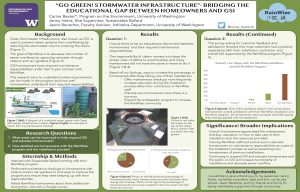“GO GREEN! STORMWATER INFRASTRUCTURE” – BRIDGING THE EDUCATIONAL GAP BETWEEN HOMEOWNERS AND GSI
Green Stormwater Infrastructure, also known as GSI, is used to prevent sewer systems from overflowing by reducing the stormwater volume entering the drains. Places like Seattle feature a combined system, merging urban runoff and sewage in one pipe, and transporting them to a treatment plant, as seen in Figure 1 (ECOSS 2019). Heavy rainstorms overwhelm the system, leading to overflow into the Puget Sound and the Duwamish River. I worked with rain gardens and cisterns (two forms of GSI) during my internship with Sustainable Ballard and Rain Wise. A cistern collects rainwater and moves it from the roof to a storage tank. It is then slowly released into the sewers. Rain gardens utilize the building’s downspout, allowing the water to soak into the ground. At Sustainable Ballard I performed maintenance checkups, ensuring that local homeowners were taking care of their installations. I went through a checklist of required tasks, asking customers if they were aware of the responsibilities. The study’s purpose was to help RainWise strengthen its program and its customers’ understanding of maintenance. We found there was a lack of knowledge about how installations functioned and how to take care of them. As a result, we found many installations lacking proper maintenance and therefore weren’t functioning as intended. We learned that further education regarding these installations is not only necessary, but will also lead to less malfunction, and thereby less overflow into the local waterways.
